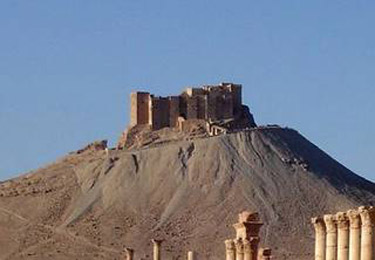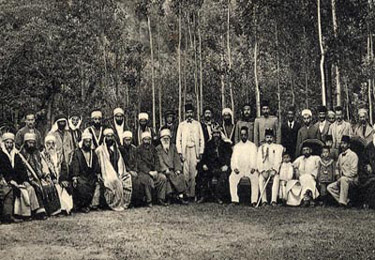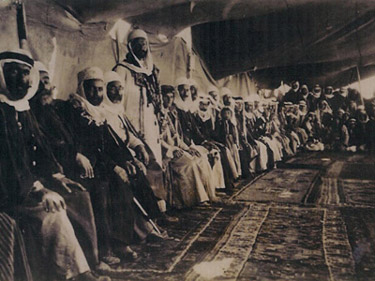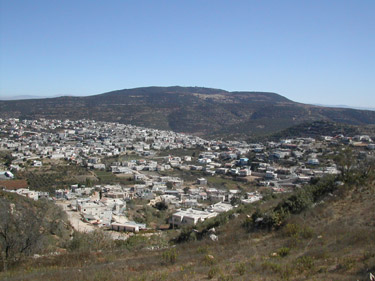|
A close-knit community that calls the mountains of Syria,
Lebanon, Palestine and Jordan their natural home, the Druze are
bound by religion, culture, loyalty and a strong sense of
family. It is believed they number more than one million
worldwide, although up to 80 percent still live in Syria and
Lebanon while as many as seven percent are, today, citizens of
Israel. There may also be as many as 100,000 scattered over the
US, Canada, Australia, West Africa and throughout the Middle
East. What is it about their history that has fuelled their
fierce loyalty to one another to the extent they even have their
own flag?
 |
 |
They have been described as, “one of the most misunderstood and
understudied minorities in the world,” and it is this
impenetrability that envelops the Druze in an air of mystery.
Away from their respective mountain fastness they tend to blend
into the community at large and shy away from discussing their
beliefs. They do not proselytize and their religion is closed to
converts, while inter-marriage is strongly discouraged as is
divorce. It is thought their ranks were sealed for ever as long
ago as 1043.
Together they arguably make up the world’s most exclusive club.
For instance, a Druze friend of mine has a book printed with the
names and contact details of his entire extended family
worldwide.
The esoteric core of the religion is reserved for only a
fraction of Druze considered pious and devoted enough to be
worthy of its secrets. These evolved individuals, who must go
through a lengthy initiation process, are known as “uqqal” or
enlightened, as opposed to the majority, the “juhhal” or
unenlightened. The latter are not given access to the Book of
Wisdom but are expected to conduct their lives according to an
unbending code.
This code includes; submission to the one Creator, rejection of
evil, truthfulness, and a commitment to helping co-religionists.
They are also encouraged to be hospitable, generous and
honourable. Males are expected to be good providers and women
virtuous. Couples are encouraged to continue the line with sons.
Women who have lost their husbands, and children whose parents
have died are well looked after by the community at large, as
are the very poor; slavery is not tolerated; the co-existence of
all Middle Eastern religions is revered and those who stray too
far from ‘the way’ such as marrying outside it, can be
ostracised by the community. Many Druze males living in the West
will return to their village to find a bride when the time comes
to marry.
The origins of the Druze are as clouded in mystery as their
beliefs. It is generally believed that the sect was born in
Egypt around 1017 when the sixth Fatimid Caliph Al Hakim bi-Amrih
Allah broke away from Shiite Islam with the dream of unifying
the Islamic world, and later spread to the Levant.
 |
|
Drize leaders
meeting in jebel Ai-Druze, Syria, 1926 |
 |
|
Bite, Druze
Villaqge |
It is the thought that the term “Druze” originates from the name
of one of the Caliph’s aides - Muhammad Al-Darazi, a preacher
who inspired many new followers. Another school of thought says
it comes from a Persian word meaning “heaven”.
When Caliph Al Hakim disappeared without trace, some believe he
was murdered: he was succeeded as Caliph by his young son Ali
Al-Zahir, who ordered the Fatimid Army to slaughter the Druze
leading to the massacre of 5000 in Antioch and many more in
Aleppo.
By the time Al-Zahir had brought an end to the killing in 1026
many Druze had fled to establish mountain enclaves in Lebanon,
Syria and Palestine, which it was hoped were secure places where
families could live and practice their monotheistic religion
that respects all prophets in peace. It was due to persecution
that Druze religious leaders decided they would accept no new
converts, an injunction that still stands ten centuries on.
During the following decades they lived quietly and
self-sufficiently tending their orchards and olive groves,
increasing their flocks, growing vegetables and baking bread.
Despite this, when the European Crusaders sailed into the
Levant, the Druze from Lebanon’s Chouf mountain region (where
the Lebanese politician Walid Jumblatt has a mountain home
today) cemented their warrior reputation when they were given
the responsibility to ensure the enemy could not push out from
the coast inland.
Led by two families, the Tanukhs and the Arslans, Druze fighters
displayed such a formidable skill that Egypt’s Mamluk rulers
were so impressed they helped them to fend off the Crusader
threat. Over the following centuries, they were forced to endure
many conflicts and civil wars. Their political heyday came in
the 16th century when the Druze under the leadership of the
Ma’an family ruled virtually all of southern Lebanon.
A descendant of the Ma’ans was Prince Fakhreddin II, a highly
intelligent and very powerful ruler who extended Druze
domination throughout Syria, signed a clandestine military pact
with Duke Ferdinand I of Tuscany and opened the country to
Western influences. It was he who opened the door to foreign
consulates, French hostelries and Christian missionaries.
In 1860, the Druze became embroiled in a civil war with
Lebanon’s French-backed Christian Maronites; a conflict that was
eagerly stirred up by the Ottomans in an attempt to divide and
rule. In 1926, Syria’s Druze launched an insurgency against the
French occupiers, known as “the Druze Rebellion”, which
consolidated their tough reputation.
Certainly, Adib ibn Hasan Shishakli, an ethnic Kurd who was
President of Syria for a brief period in the mid-20th century,
feared the wrath of the Druze and went out of his way to crush
their power. “My enemies are like a serpent: the head is the
Jebal Druze, the stomach Homs and the tail Aleppo. If I crush
the head, the serpent will die,” he is quoted as saying. Besides
attacking Druze, he instituted a policy of blackening their name
and discrediting their beliefs with forged texts.
According to the writer Pam Rohland, Druze beliefs: “include
loyalty to the country in which they reside although all
maintain close ties with their homeland. Syrian Druze serve in
the Syrian military, Lebanese Druze serve in the Lebanese army
and Israeli Druze serve in the Israeli Defence Forces… However,
they “are reluctant to battle other Druze” and they will often
defect rather than take up arms against their cousins.”
Today, Druze living in Lebanon, Syria and Israel are recognised
by those states as a community with its own system of religious
laws and its own flag with five colours, each respectively
symbolizing the mind, the soul, the truth, the cause and the
effect. They may be small in numbers but wherever they are,
their impact on the community at large and on history has been
and continues to be great.
|